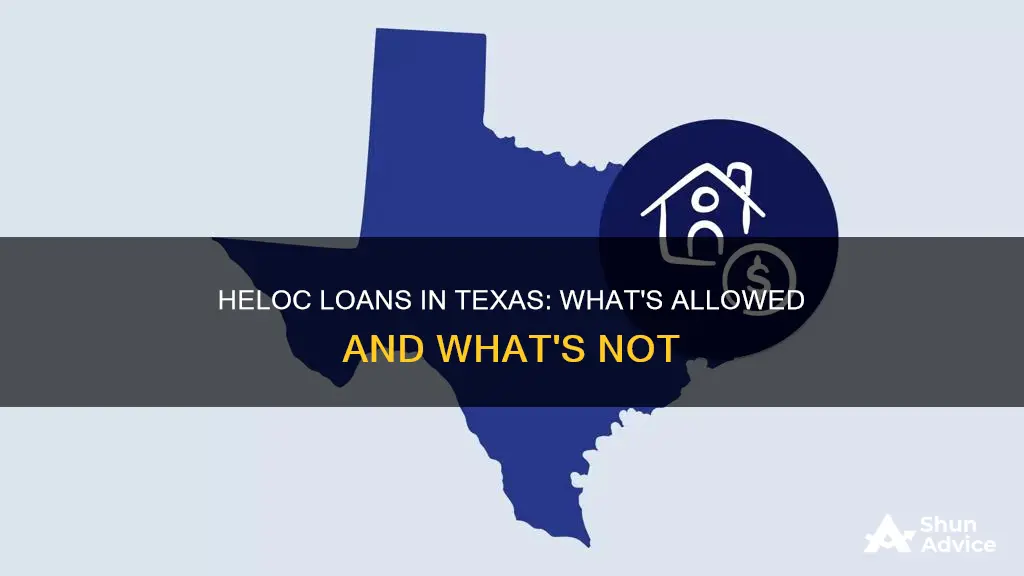
Texas has some of the strictest rules for home equity loans, with a robust regulatory framework designed to safeguard consumers and homeowners. Texas law places restrictions on home equity loans, and the state didn't allow this type of loan until 1997. Texas's regulations are unique compared to other states, aiming to protect homeowners from excessive borrowing and over-leveraging their properties. So, does Texas allow HELOC loans?
| Characteristics | Values |
|---|---|
| Availability | HELOC loans are available in Texas |
| Restrictions | Texas has some of the strictest rules for home equity loans |
| Purpose | HELOC loans allow homeowners to tap into their home equity |
| Loan-to-Value Ratio | Homeowners can borrow up to 80% of their home's value |
| Primary Residence Requirement | Only available for primary residences, not for second homes or investment properties |
| Single Loan Rule | Only one home equity loan or line of credit at a time |
| Minimum Draw | Initial draw must be at least $4,000 |
| Underwriting | Lenders evaluate financial health and assess risk |
| Closing | Texas law requires a 12-day waiting period between application and closing |
| Right of Rescission | Borrowers have a 3-day right to cancel the loan without penalty |
| Interest Rates | Variable interest rates, typically prime plus 3% |
| Fees | Lenders are capped at charging a max of 2% in fees based on the loan amount |
| Collateral | Lenders cannot demand extra collateral beyond the home |
| Authorization | Lenders must be authorized and licensed to offer home equity financing |
What You'll Learn

Texas has strict rules for home equity loans
Texas has some of the strictest rules for home equity loans in the United States. The state's laws are designed to protect homeowners from over-leveraging their properties and taking on undue risk. While these rules may appear stricter than normal, they provide a financial safety net for Texas residents.
One of the key differences between Texas and other states is that Texas did not allow home equity loans until 1997. Even after legalising them, Texas legislation restricted loan sizes to prevent homeowners from taking on more debt than their house is worth. The state also has a unique regulatory framework for HELOCs (home equity lines of credit), which are governed by rules that safeguard consumers and ensure responsible lending practices.
Texas law sets a limit on the amount of home equity that can be borrowed against. This limit is typically 80% of the home's value, minus any existing mortgage balance. For example, if a homeowner has a house worth $300,000 and owes $150,000 on their mortgage, they could borrow up to $90,000 through a HELOC. This ensures that homeowners maintain a substantial equity stake in their property, reducing the risk of foreclosure.
There are also specific requirements for Texas A6 home loans. The combined loan-to-value (CLTV) ratio cannot exceed 80%, meaning that all mortgages on the property must not total more than 80% of the home's value. Lenders are also capped at charging a maximum of 2% in fees based on the loan amount, and they are not allowed to demand extra collateral or assets beyond the home itself. Texas law also includes a 12-day waiting period between application and closing, giving homeowners time to reconsider the loan.
In addition to these state-specific regulations, there are also some general requirements for obtaining a HELOC in Texas. For example, lenders typically require borrowers to have a stable income and employment history, as well as a low debt-to-income (DTI) ratio. Borrowers must also reside in the home for at least a year before taking out a HELOC, and the loan can only be for a primary residence, not a second home or investment property.
Taxslayer: Student Loan Interest Deduction Eligibility and Benefits
You may want to see also

Homeowners can borrow up to 80% of their home's value
Texas has some of the strictest rules for home equity loans. The state's laws restrict loan sizes to ensure that homeowners do not take on excessive debt. Texas law sets the maximum amount that can be borrowed through a home equity loan or line of credit (HELOC) at 80% of the property's appraised value. This includes any existing mortgage balance. For example, if a homeowner has a property worth $300,000 and owes $150,000 on their mortgage, they can borrow up to an additional $90,000 through a HELOC. This means they would have a total loan-to-value (CLTV) ratio of 80%.
To ensure responsible lending practices, Texas law requires homeowners to have substantial equity in their homes before taking out a HELOC. This means that homeowners must have at least 20% equity in their property before they can borrow against it. Lenders will also assess the borrower's ability to repay the loan by examining their income, employment status, and employment history. A stable income and employment history are crucial factors in securing a HELOC. Additionally, borrowers must provide proof of income, such as pay stubs, tax returns, and bank statements.
Texas has unique regulations for HELOCs that distinguish them from those in other states. One such regulation is the primary residence requirement, which stipulates that HELOCs can only be taken out on the homeowner's primary residence. This means that loans cannot be obtained for second homes or investment properties. Texas law also includes a single loan rule, which allows homeowners to have only one home equity loan or line of credit at a time. After obtaining a HELOC, borrowers must wait at least 12 months before taking out another loan or refinancing. This regulation further protects homeowners from excessive borrowing.
The underwriting process is an essential step in the lending process, as it allows the lender to evaluate the borrower's financial health and assess the risk of lending. During this process, the lender reviews the borrower's credit history, income, assets, debts, and appraisal results. Texas law also requires a twelve-day waiting period between the application and closing of a HELOC to give homeowners time to reconsider the loan. Additionally, borrowers have a three-day right of rescission after closing, during which they can cancel the loan without penalty.
Teach for America: Loan Forgiveness and You
You may want to see also

Texas law requires a 12-day waiting period before closing
Texas has some of the strictest rules for home equity loans. Texas law requires a 12-day waiting period between application and closing to allow homeowners time to reconsider the loan. This is known as the "12-day letter". This waiting period is in place to ensure that homeowners don't take on excessive debt and to safeguard consumers. It's important to note that this 12-day period is a minimum, and the process of closing a HELOC loan in Texas can often take anywhere from 30 to 90 days.
During the waiting period, homeowners can use the time to carefully consider the financial implications of the loan and ensure they are making an informed decision. This period also allows homeowners to compare rates from different lenders and make sure they are getting a competitive offer. It is always recommended to shop around and not rush into any loan agreement.
After the waiting period and once the application is approved, the borrower proceeds to the closing stage. During closing, the final details of the loan are finalized, legal documents are signed, and any closing costs associated with the HELOC are paid. It is important to understand that closing costs may vary, and in some cases, there may be no fees involved.
In addition to the 12-day waiting period, Texas law also provides a three-day right of rescission after closing. This means that even after signing the loan agreement, homeowners have three days to cancel the loan without penalty if they change their mind. This further protects homeowners and gives them an additional opportunity to reconsider their decision.
Target Employee Loans: What's the Deal?
You may want to see also

Lenders must be authorised and cannot charge more than 2% in fees
Texas has a robust regulatory framework for HELOC loans, with specific restrictions in place to safeguard consumers and ensure responsible lending practices. One critical aspect of these regulations is the requirement for lenders to be authorised and their fees capped at 2% of the loan's principal amount.
Lender authorisation is a crucial safeguard in Texas's HELOC market. Lenders must possess a license to offer home equity financing, ensuring they operate within the state's legal framework and adhere to stringent eligibility criteria. This authorisation process helps protect borrowers from unscrupulous or unqualified lenders and provides a layer of security for homeowners considering HELOC loans.
The 2% fee cap on lender charges is another key component of Texas's HELOC regulations. This cap applies to the loan's principal amount and excludes fees for appraisals, surveying, or title services. By limiting fees to a relatively small percentage, Texas law helps prevent excessive costs from accumulating for borrowers. This measure is particularly important given the variable interest rates associated with HELOC loans, which can make budgeting challenging for borrowers.
The combination of authorised lenders and capped fees helps Texas homeowners access HELOC loans with greater financial security. These regulations are designed to prevent borrowers from taking on excessive debt and protect them from unfair lending practices. While they may seem restrictive, these rules provide a financial safety net, minimising the risk of homeowners finding themselves in financial distress due to overwhelming loan obligations.
In summary, the requirements for lender authorisation and the 2% fee cap on HELOC loans in Texas are essential components of the state's consumer protection framework. These measures help ensure that homeowners can access home equity financing while minimising the risk of financial hardship, reflecting Texas's conservative approach to borrowing and property rights.
Life Insurance Loan: Impact on Premium Payments?
You may want to see also

HELOCs are for primary residences only
Texas has some of the strictest rules for home equity loans. Texas law places restrictions on home equity loans, and HELOCs in the state are governed by unique regulations that safeguard consumers and ensure responsible lending practices. One of these regulations is the primary residence requirement, which means that you can only take out a HELOC loan on your primary residence in Texas. This means that you won't qualify if you want to take a loan on a second home or investment property.
The primary residence requirement for HELOCs in Texas is in place to protect homeowners from financial risk. Lenders consider loans on primary residences to be less risky than those on investment properties because homeowners are more likely to prioritise repaying loans on their main home. As a result, HELOCs on investment properties are less common and have stricter requirements, higher interest rates, and higher fees.
To qualify for a HELOC on a primary residence in Texas, you must have substantial equity in your home. Lenders typically allow homeowners to borrow up to 80% of their home's value minus the amount they owe on their mortgage. For example, if your home is worth $300,000 and you owe $150,000, you could borrow up to $90,000 through a HELOC. Additionally, you will need to provide proof of income, such as pay stubs, tax returns, and bank statements, to demonstrate that you can repay the loan. Lenders will also consider your debt-to-income (DTI) ratio, with many preferring a DTI of 43% or lower.
The process of obtaining a HELOC on a primary residence in Texas involves underwriting, where the lender evaluates your financial health and assesses the risk of lending to you. This is followed by the closing stage, where you finalise the loan details, sign legal documents, and pay any closing costs. Texas law requires a twelve-day waiting period between application and closing to allow homeowners time to reconsider the loan, and you have the right to cancel the loan without penalty within three days after closing.
Understanding Loans: Impact on Assets and Liabilities
You may want to see also
Frequently asked questions
Yes, HELOC loans are allowed in Texas. However, Texas has some of the strictest rules for home equity loans.
Texas law sets the maximum amount that can be borrowed through a HELOC loan at 80% of the home's value. For example, if your home is worth $200,000, and you don't have a mortgage, the largest home equity loan you could obtain would be $160,000. If you still owed $60,000 on your mortgage, the maximum you could take out would be $100,000.
HELOC loans in Texas are governed by unique regulations that are set up to safeguard consumers and ensure responsible lending practices. These include the primary residence requirement, the single loan rule, and the minimum draw.







